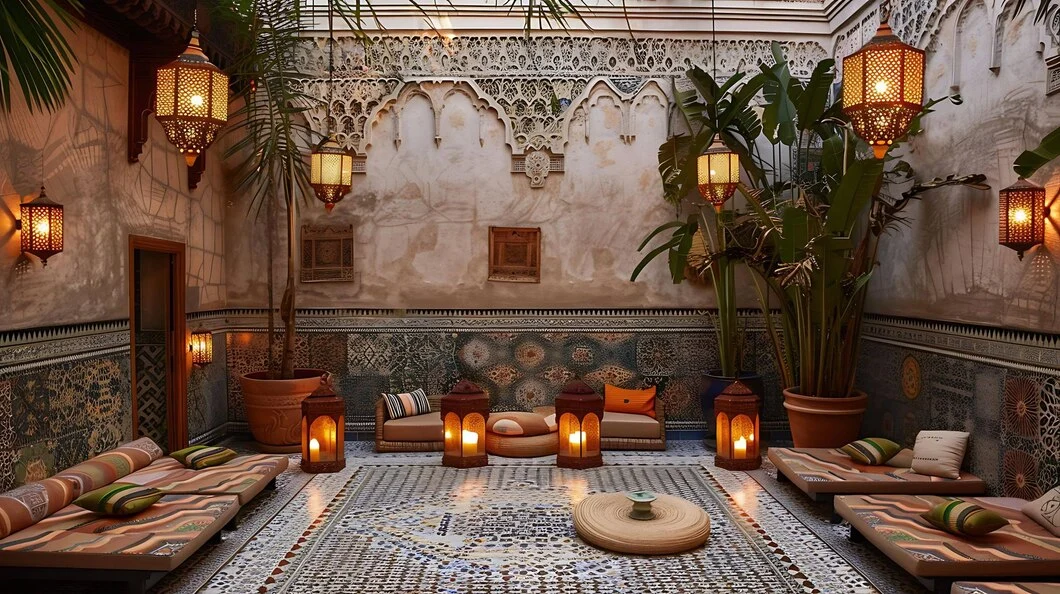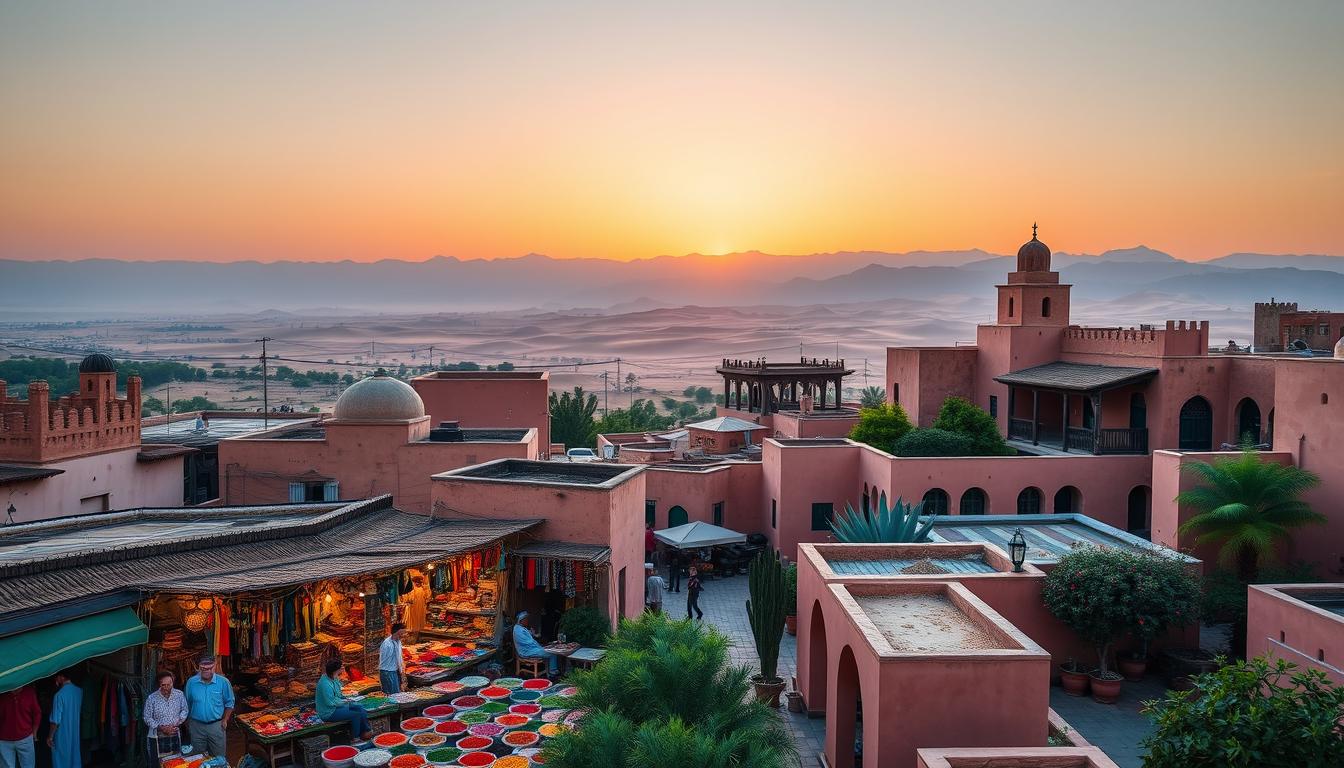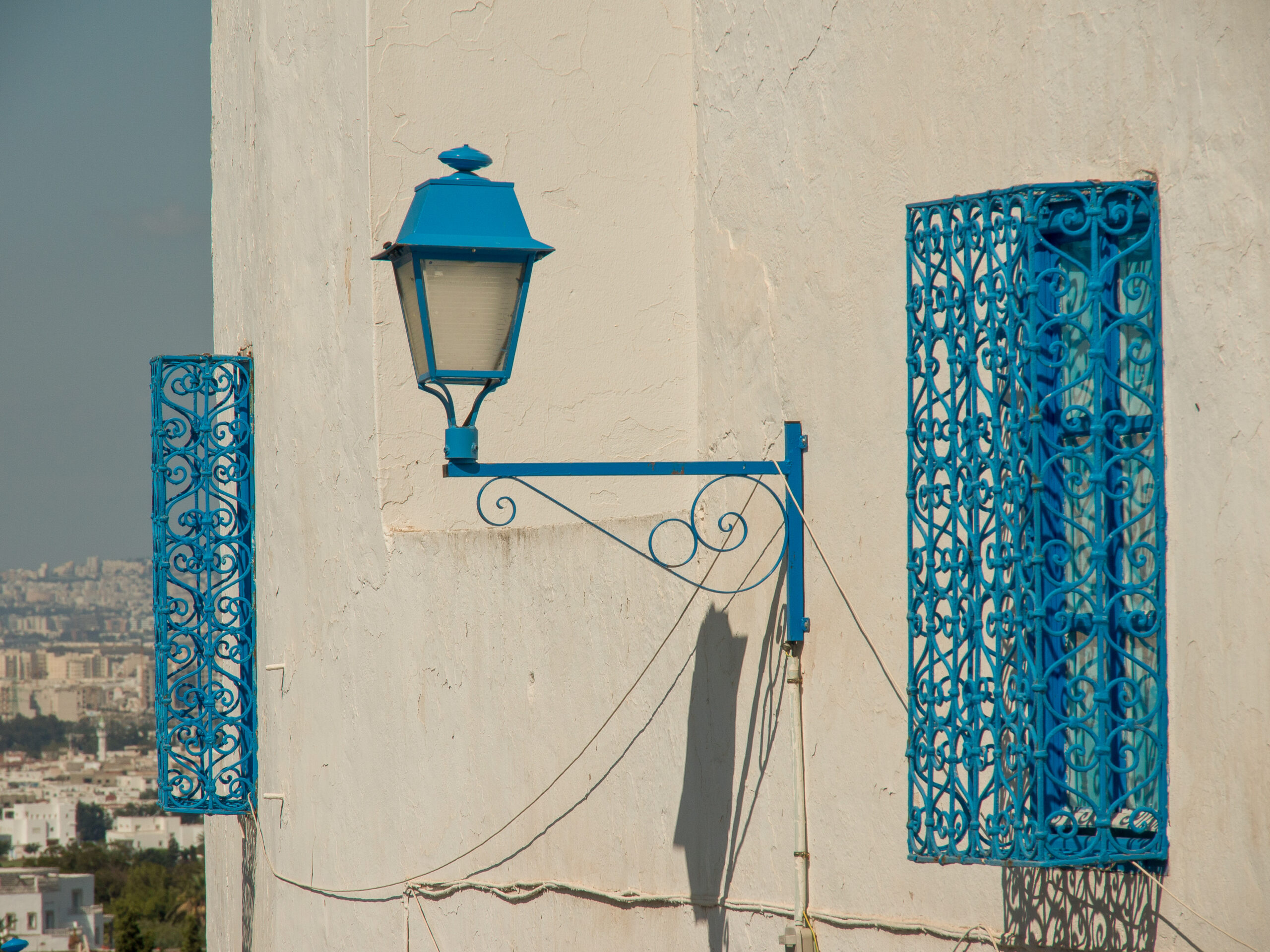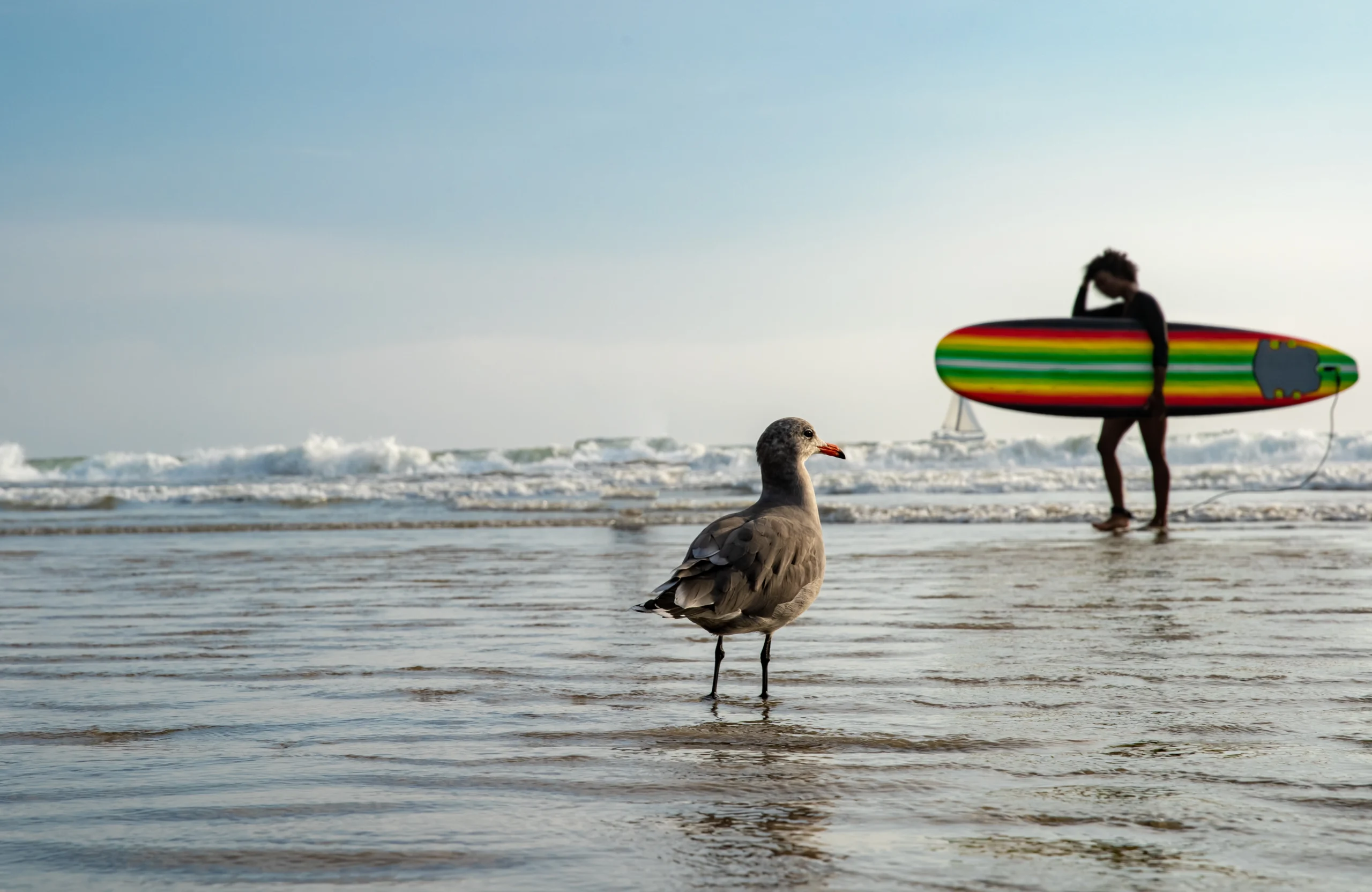When you visit Morocco, you’re drawn to its rich history. Bab el Mansour in Meknes is a key part of this allure. It’s not just a gate; it’s a masterpiece of Moroccan architecture. This stunning structure welcomes you into the heart of the city, filled with history and culture.
Built in the 18th century, Bab el Mansour is more than a tourist attraction. It’s the city’s soul, showing off the skill of Moroccan culture. Standing before it, you’ll see stories of sultans and old times. It’s a journey through history.
Exploring Bab el Mansour is key to understanding Morocco. It’s a must-see for anyone wanting to know this land’s true essence. For your next adventure, check out Morocco Highlights 2025 luxury tours.
Overview of Bab el Mansour
Bab el Mansour in Meknes, Morocco, is a cultural landmark that shows the city’s rich history. It’s a stunning gateway that symbolizes the grandeur of Sultan Moulay Ismail’s reign. It’s a must-see for anyone interested in Morocco’s heritage.
Historical Significance
This grand entrance shows the architectural dreams of the time and Meknes’ strategic importance as a former capital. Travelers in Meknes are drawn to its history. It tells a lot about Morocco’s past and the impact of its leaders.
Architectural Features
The architectural details of Bab el Mansour are impressive. It features elaborate mosaics and detailed designs typical of Moroccan style. Visitors are amazed by its size and the beautifully crafted arches that showcase the artistic skills of the time.
Visitor Accessibility
Getting to Bab el Mansour is easy for tourists in Meknes. Its central location makes it simple to visit. The area around it is filled with attractions, making your visit even more rewarding.
| Feature | Description |
|---|---|
| Location | Meknes, Morocco |
| Significance | Cultural landmark and historical site |
| Accessibility | Easily reachable from the city center |
| Architectural Style | Moroccan with intricately designed mosaics |
The History Behind Bab el Mansour
The majestic Bab el Mansour in Meknes, Morocco, has a rich history. It was built in the late 17th century and finished in 1732. Sultan Moulay Ismail oversaw its construction, making it a symbol of the era’s grandeur.
Construction Details
The building of Bab el Mansour was a major achievement in Moroccan architecture. Its large size and detailed designs make it a grand entrance to the city. Local materials were used to create a strong structure with beautiful tile work and stone carvings.
Influence of Sultan Moulay Ismail
Sultan Moulay Ismail’s influence was key in creating Bab el Mansour. He was a powerful leader of the Alaouite dynasty. He wanted to show his strength and welcome visitors to Meknes through this gate.
Restoration Efforts
Restoration work has been vital in keeping Bab el Mansour beautiful. These efforts aim to keep its details and structure intact. Local groups and authorities work together to protect this important landmark in Meknes.
| Key Aspects | Details |
|---|---|
| Construction Period | Late 17th century to 1732 |
| Influential Figure | Sultan Moulay Ismail |
| Main Materials | Local stone and tiles |
| Restoration Initiatives | Local authorities and cultural organizations |
Architectural Style and Design
The architectural style of Bab el Mansour is a mix of Almohad and Moroccan elements. This stunning gateway has unique architectural features. These features make it stand out in Moroccan architecture.
Almohad and Moroccan Elements
The Almohad influence is seen in the bold geometric shapes and large size. Moroccan elements add to the design with detailed decorative motifs. This mix of culture and artistry is truly beautiful.
Colorful Tile Work
The colorful tile work on the structure is a highlight. It brings vibrancy and shows off the skill in traditional Moroccan architecture. Each tile forms stunning patterns, drawing in visitors.
Decorative Arches
The decorative arches of Bab el Mansour catch the eye. They show the elegance of Moroccan design. These arches frame the entrance, adding to the beauty of Moroccan architecture.
| Feature | Description |
|---|---|
| Architectural Style | Combines Almohad and Moroccan elements |
| Market Color Palette | Vibrant hues reflected in tile work |
| Prominent Features | Intricate decorative arches enhance entrance |
Visiting Bab el Mansour
Planning your trip to Bab el Mansour can make your visit better. Knowing the opening hours, admission fees, and the best times to visit is key. Here’s everything you need to know for a smooth and fun trip.
Opening Hours
Bab el Mansour is open every day. The hours are:
| Day | Opening Hours |
|---|---|
| Monday – Friday | 9:00 AM – 6:00 PM |
| Saturday – Sunday | 9:00 AM – 7:00 PM |
Admission Fees
Visiting Bab el Mansour is usually free. This makes it easy for everyone to enjoy. But, some special exhibitions might cost a bit, so it’s good to check ahead of time.
Best Times to Visit
For a great visit to Bab el Mansour, keep these tips in mind:
- Early mornings are less crowded, perfect for photos and exploring.
- Weekdays are quieter than weekends.
- Spring and fall are the best times for fewer tourists and nicer weather.
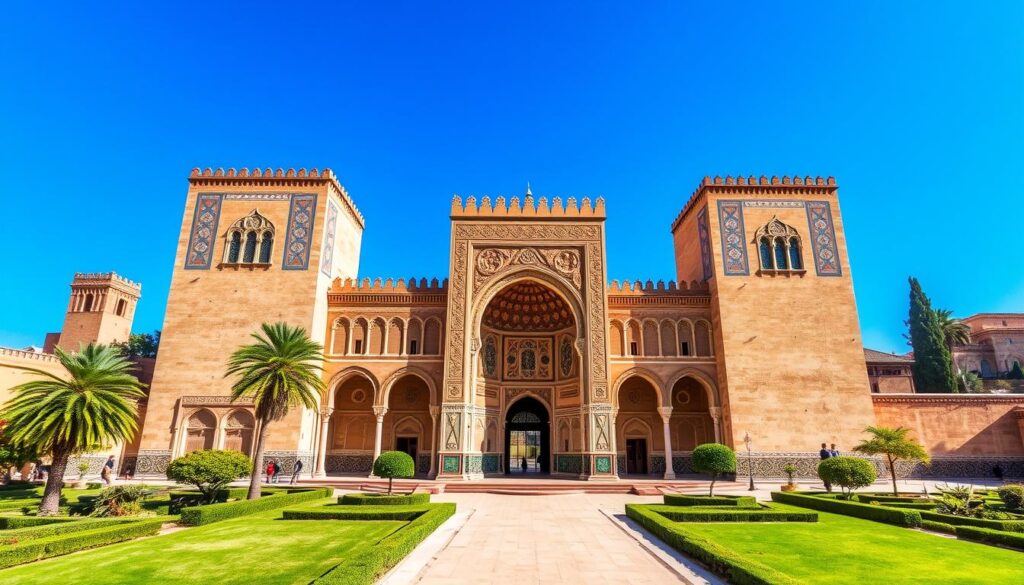
Nearby Attractions
Exploring Meknes reveals a treasure trove of attractions near Bab el Mansour. Each spot offers unique cultural experiences and deep dives into the area’s history.
Meknes Medina
The Meknes Medina is alive with shops and cafes. Its narrow streets show off traditional craftsmanship and local culture. Visitors can find handmade goods and try local foods, making it a top spot in Meknes.
Mausoleum of Moulay Ismail
Close to Bab el Mansour is the Mausoleum of Moulay Ismail. This place honors Meknes’ founder and shows the city’s royal past. Inside, you’ll see stunning Moroccan architecture and detailed tile work, giving a peek into Meknes’ culture.
St. Louis Gate
The St. Louis Gate is known for its Islamic architecture. This historic entrance is a highlight of the city, showing off Meknes’ architectural talent. Visiting these spots lets you see the rich cultural tapestry of Meknes.
Cultural Identity of Meknes
The cultural identity of Meknes shines through its historical structures, like gateways. These marvels are more than just city entrances. They reflect the city’s rich history and mix of cultures. Exploring these gateways reveals the heart of Meknes.
Importance of Historical Gateways
Historical gateways are key to Meknes’ cultural scene. They mark the city’s history and remind us of its past. Bab el Mansour is a standout example, showing Morocco’s architectural beauty and strength.
These structures are not just for entry. They are vital in keeping Meknes’ culture alive.
Bab el Mansour’s Role in Local Culture
Bab el Mansour is a big part of Meknes’ culture. It’s where locals celebrate and gather. Its design draws artists and performers, showing how history connects us.
Exploring Meknes, you see how Bab el Mansour ties the past to today. It shows the importance of bab el mansour meknes morocco in the city’s identity.
What to Expect During Your Visit
Visiting Bab el Mansour Meknes is a unique experience filled with history and culture. It’s a key tourist spot known for its stunning gateway. Here, you can learn a lot about its past and see its beautiful art.
Guided Tours
Guided tours are available to make your visit even better. Guides share interesting facts about the gateway and its history. They talk about Sultan Moulay Ismail’s influence and Meknes’ rich history. These tours are small, so you get a personal touch.
Interactive Exhibits
Interactive exhibits let you dive into Bab el Mansour’s history. You’ll find multimedia shows and hands-on activities. They make the gate’s stories come alive, making your visit fun and educational.
Photography Opportunities
The structure is perfect for taking photos. Its detailed designs and bright colors are great subjects. The changing light and shadows make your photos even more special, keeping your visit memorable.
Events and Festivals
Visiting Meknes lets you dive into lively cultural events. These events celebrate the area’s rich heritage. Near Bab el Mansour, a key historical site, many annual celebrations take place. They showcase local traditions, art, and music, giving you a peek into Moroccan culture.
Annual Celebrations
Meknes buzzes with life all year round. It hosts various annual celebrations that highlight local customs. These events bring people together, creating a sense of community. Some notable celebrations include:
- Festival of the Roses
- Meknes Wine Festival
- Islamic New Year Celebrations
At these events, you can see unique cultural practices. You’ll also get to taste traditional dishes and join in on parades. All while enjoying the beauty of Meknes landmarks.
Cultural Performances
Meknes is also known for its cultural performances. These events bring the local arts scene to life. You’ll see traditional music, dance, and theater. Some popular cultural expressions include:
- Live music concerts by Moroccan artists
- Folkloric dance performances that celebrate local history
- Art exhibitions by local artists and artisans
Attending these performances adds to your travel experience. It lets you appreciate Meknes’ vibrant history. For the best experience, check local listings to plan your trip around these events.
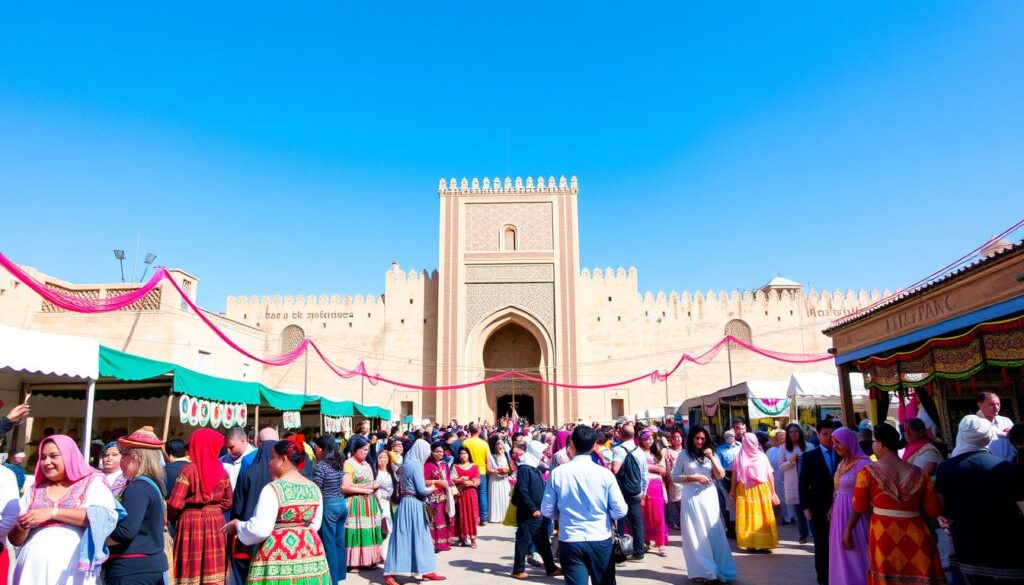
| Event Type | Typical Month | Highlights |
|---|---|---|
| Festival of the Roses | May | Flower parades, traditional music |
| Meknes Wine Festival | October | Tastings, culinary workshops |
| Islamic New Year Celebrations | September/October | Cultural displays, community feasts |
Tips for First-Time Visitors
Planning a trip to Bab el Mansour in Meknes? You can make your visit better with some helpful tips. Knowing what to bring, how to act, and safety tips will help you travel safely and enjoyably.
Must-Have Essentials
When you visit Bab el Mansour, don’t forget to bring these items:
- Water bottle: Stay hydrated while exploring the area.
- Comfortable shoes: Wear sturdy footwear to navigate uneven surfaces.
- Sun protection: Sunscreen and hats are important for sunny days.
- Camera: Capture stunning photos of the architectural beauty.
Local Etiquette
Respecting local customs can make your visit better. Here are some important points to remember:
- Greetings: A friendly “Salam” goes a long way in initiating interactions.
- Dress modestly: Dress appropriately in cultural sites and religious areas.
- Photography permissions: Always ask before taking photos of people.
Safety Precautions
Traveling safely is key for a good visit. Remember these safety tips:
- Stay aware: Keep an eye on your belongings to avoid pickpocketing.
- Local emergency numbers: Familiarize yourself with local contacts for assistance.
- Traveling in groups: Whenever possible, explore Bab el Mansour with others for added safety.
By following these tips, you can have a memorable and safe trip to Bab el Mansour. Get ready to explore the culture, enjoy the scenery, and make the most of your visit!
Culinary Delights Around Bab el Mansour
Exploring Bab el Mansour opens a world of rich flavors and memorable meals. The area is home to many local restaurants. They offer an authentic taste of Moroccan cuisine, making your dining experience as rich as your historical exploration. Here, you’ll find aromatic spices and fresh ingredients, celebrating Moroccan heritage.
Local Restaurants
Many local restaurants cater to all tastes, blending traditional and modern flavors. Eating here not only fills your belly but also shows you Moroccan hospitality.
- Le Kent: Known for its cozy atmosphere and traditional dishes.
- Restaurant Maure: Offers a stunning terrace and a wide menu of Moroccan cuisine.
- Café Nuss: Famous for its lively vibe and tasty tagines.
Traditional Moroccan Cuisine
Traditional Moroccan cuisine is all about rich flavors. Ingredients like saffron, cumin, and coriander make every dish special. Talking to locals, you’ll hear about family recipes passed down through generations, adding a personal touch to every meal.
Recommended Dishes
When you visit local restaurants, try these dishes:
- Tagine: A slow-cooked stew with chicken, lamb, or vegetables.
- Couscous: Served with meat and vegetables, it’s a Moroccan favorite.
- Harira: A warm soup, great for chilly days.
Souvenir Shopping Opportunities
Exploring Meknes is a thrilling chance to find unique souvenirs. This city is famous for its artisan shops. They offer a wide range of local products, perfect for a keepsake.
Visitors are amazed by the craftsmanship here. It makes shopping a highlight of your trip.
Artisan Shops
Meknes has many artisan shops near famous landmarks. Each shop is filled with handcrafted goods, from pottery to textiles. The artisans put their heart and skill into every piece.
Visiting these shops supports local talent. It’s a great way to bring a piece of Morocco’s culture home.
Unique Local Products
In Meknes, you’ll find many unique items. There are handwoven rugs, leather goods, and ceramics. Each item has a story behind it, making them special.
Shopping for souvenirs is a way to remember your trip. It also lets you connect with the area’s traditions. For more on Meknes, check out this resource.
Transportation Options to Bab el Mansour
Getting to Bab el Mansour in Meknes is easy with many transportation choices. You can use public transit, rent a car, or take a taxi. Each option makes visiting Bab el Mansour more enjoyable.
Public Transit
Meknes has a good public transit system. It can take you near Bab el Mansour. Buses and shared taxis are cheap and run often. Just check the schedule to plan your trip well.
Car Rentals
Renting a car gives you freedom to explore. Many car rental companies are in the city. You can see Meknes and nearby places at your own speed. Parking is usually easy to find near big sights like Bab el Mansour.
Taxi Services
Taxis are easy to find and get you to Bab el Mansour quickly. You can choose a regular taxi or a ride-hailing service. It’s a good choice after a long day of seeing the sights.
| Transportation Option | Advantages | Considerations |
|---|---|---|
| Public Transit | Cost-effective, frequent schedule | May require transfers |
| Car Rentals | Flexible travel plans, explore at leisure | Potential parking fees, traffic |
| Taxi Services | Convenient, direct routes | Rates may vary based on distance |
Conclusion: Your Next Adventure Awaits
Visiting Bab el Mansour in Meknes, Morocco, is more than seeing a historical gateway. It’s a dive into Moroccan culture and history. You’ll be amazed by the architecture and the stories it tells.
This place shows off Moroccan art and history. It’s a must-see for anyone interested in culture and history.
Reflection on the Experience
Every moment at Bab el Mansour is a chance to explore Meknes’ culture. Walking through its archways, you feel history and beauty around you. It connects you to Meknes and Moroccan culture in a deep way.
Encouragement to Explore Further
Meknes and its areas have more to see, like amazing buildings, lively markets, and great food. Exploring these will make your trip unforgettable. Each place adds to your journey, inviting you to discover more.
FAQ
What is Bab el Mansour in Meknes, Morocco?
Bab el Mansour is a stunning historical monument in Meknes, Morocco. It’s a key landmark that marks the entrance to the imperial city of Meknes. The architecture and craftsmanship from the 18th century are truly exceptional.
Why should I visit Bab el Mansour?
Visiting Bab el Mansour is a must in Meknes. It showcases the grandeur of Moroccan history and the artistry of its design. It’s a top tourist attraction in the region.
How can I access Bab el Mansour?
Bab el Mansour is easy to reach in Meknes. It’s located in the city’s medina and can be walked to. It’s a key part of exploring Meknes’ historical sites.
What are the opening hours for Bab el Mansour?
Bab el Mansour is open during the day. The hours change with the seasons. It’s best to check local listings or ask at your accommodation for the latest information.
Are there any admission fees to enter Bab el Mansour?
There’s no admission fee to visit Bab el Mansour. This makes it a great addition to your travel plans without breaking the bank.
What is the best time to visit Bab el Mansour?
The best times to visit Bab el Mansour are early morning or late afternoon. These times help you avoid crowds and enjoy a peaceful visit.
What nearby attractions should I explore after visiting Bab el Mansour?
After Bab el Mansour, check out the Mausoleum of Moulay Ismail and the Meknes Medina. These sites offer unique insights into Meknes’ history and culture, enriching your travel experience.
What should I know about local etiquette while visiting Meknes?
When in Meknes, respect local customs and traditions. Dress modestly and greet locals in Arabic or French. This promotes a warm cultural exchange during your visit.


